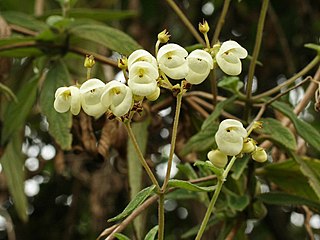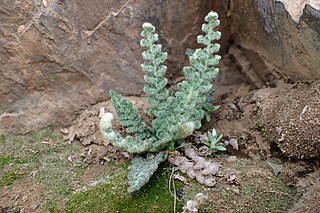
Chives, scientific name Allium schoenoprasum, is a species of flowering plant in the family Amaryllidaceae that produces edible leaves and flowers. Their close relatives include the common onions, garlic, shallot, leek, scallion, and Chinese onion.

The International Union for Conservation of Nature (IUCN) Red List of Threatened Species, also known as the IUCN Red List or Red Data Book, founded in 1964, is an inventory of the global conservation status and extinction risk of biological species. A series of Regional Red Lists, which assess the risk of extinction to species within a political management unit, are also produced by countries and organizations.

Picea martinezii, the Martinez spruce, is a medium-sized evergreen tree growing to 25–35 m tall, and with a trunk diameter of up to 1 m. It is native to northeast Mexico, where it occurs at six localities in the Sierra Madre Oriental mountains in Nuevo León. It grows at moderate altitudes from 2150–2600 m, growing along streamsides in mountain valleys, where moisture levels in the soil are greater than the otherwise low rainfall in the area would suggest.

The Arrau turtle, also known as the South American river turtle, giant South American turtle, giant Amazon River turtle, Arrau sideneck turtle, Amazon River turtle or simply the Arrau, is the largest of the side-neck turtles (Pleurodira) and the largest freshwater turtle in Latin America. The species primarily feeds on plant material and typically nests in large groups on beaches. Due to hunting of adults, collecting of their eggs, pollution, habitat loss, and dams, the Arrau turtle is seriously threatened.
Alston's cotton rat is a rodent species from South America. It is found in Brazil, Colombia, Guyana, Suriname, and Venezuela, where it inhabits lowland savannas.

Hummelinck's vesper mouse is a species of rodent in the family Cricetidae. It is found in Aruba, Brazil, Colombia, the Netherlands Antilles, and Venezuela.
Oecomys flavicans, also known as the tawny oecomys or yellow arboreal rice rat, is a species of rodent in the genus Oecomys of family Cricetidae. It is found in the mountains of northwestern Venezuela and nearby Colombia.

Handleyomys alfaroi, also known as Alfaro's rice rat or Alfaro's oryzomys, is a species of rodent in the genus Handleyomys of family Cricetidae. It is found in Belize, Colombia, Costa Rica, Ecuador, El Salvador, Guatemala, Honduras, Mexico, Nicaragua, and Panama. It was previously included in Oryzomys as Oryzomys alfaroi. Its natural habitats are subtropical and tropical lowland or montane dry forests at elevations ranging from sea level to 2500 m.

Calceolaria martinezii is a species of plant in the Calceolariaceae family. It is endemic to the Ambato plateau in central Ecuador, where it is known from only two subpopulations: one on the slopes of the Tungurahua volcano, and another close to the town of Patate.

Quercus martinezii is a species of oak found in southwestern and central Mexico. It has been found in Nayarit, Jalisco, Michoacán, Guerrero, and Oaxaca states. It is placed in Quercus section Quercus.

Cucurbita okeechobeensis, the Okeechobee gourd, is a species of gourd in the family Cucurbitaceae, native to Mexico and the United States. There are two subspecies; one is endemic to Florida, primarily in the region around Lake Okeechobee, the other to the State of Veracruz in eastern Mexico. Once abundant, it has state and federal listing as an endangered species. One of its peculiarities is the yellow corolla not so common in other Cucurbita species.
The Jamaican ameiva is a species of lizard found only in Jamaica.
Cucurbita martinezii is a plant species of the genus Cucurbita native to Veracruz, Mexico. Locals use halved fruit shells as shot glasses for alcoholic drinks. It has not been domesticated. It is generally found in areas with rivers and forests.

Cosentinia is a genus of ferns in the subfamily Pteridoideae of the family Pteridaceae with a single species Cosentinia vellea. Its native distribution ranges from the Canary Islands through Europe, northern Africa and Western Asia to the west Himalayas in the Indian subcontinent.
Maracaiba meridensis is a species of skink found in Venezuela.
Phyllomedusa chaparroi is a species of treefrog in the subfamily Phyllomedusinae endemic to Peru. Scientists have only seen it in two places. This frog has been observed between 537 and 650 meters above sea level.
Stenocereus martinezii is a species of flowering plant in the family Cactaceae, native to Sinaloa in Mexico. A candelabriform cactus typically 5 to 7 m tall, it is easy to propagate from cuttings, so local people use it to build live fences.

Micromeria glomerata, known locally as cliffthyme or thyme of Taganana, is a species of plant with woody chameleophyte flowers, belonging to the Lamiaceae family. It is a species endemic to the northeast of the Canary Island of Tenerife, whose description was first made in 1974, thanks to botanist Pedro Luis Pérez de Paz. It is a medicinal and aromatic plant with pink-purple flowers that grows at low altitude in the crevices of the slopes of the protected area of the Anaga Rural Park, located in the massif of the same name. The flexible, puberulose stem and with internodes can reach 10 to 40 centimeters in height. On the other hand, the leaves are small and flat, 8 mm long by 6 mm wide.11

Stenocereus treleasei is a species of flowering plant in the family Cactaceae, native to Oaxaca in Mexico.












